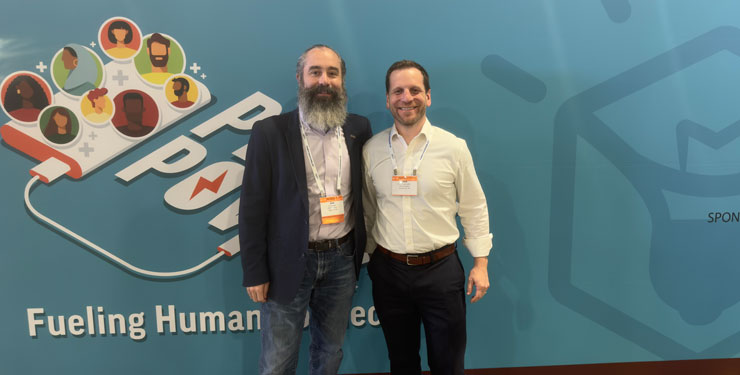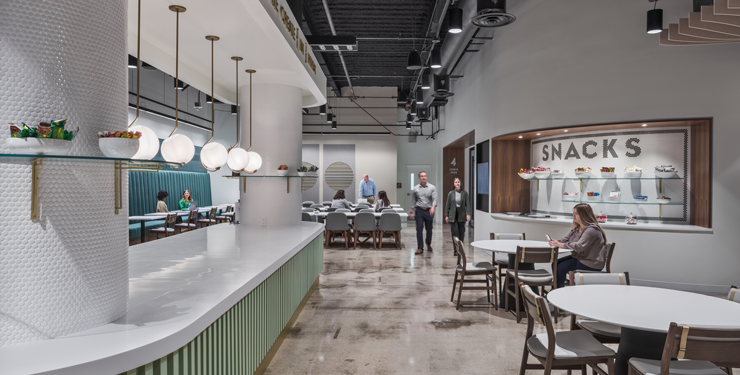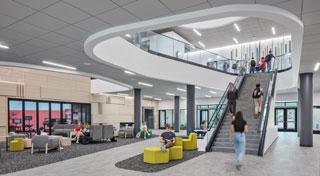
What Is the Value of the Workplace?
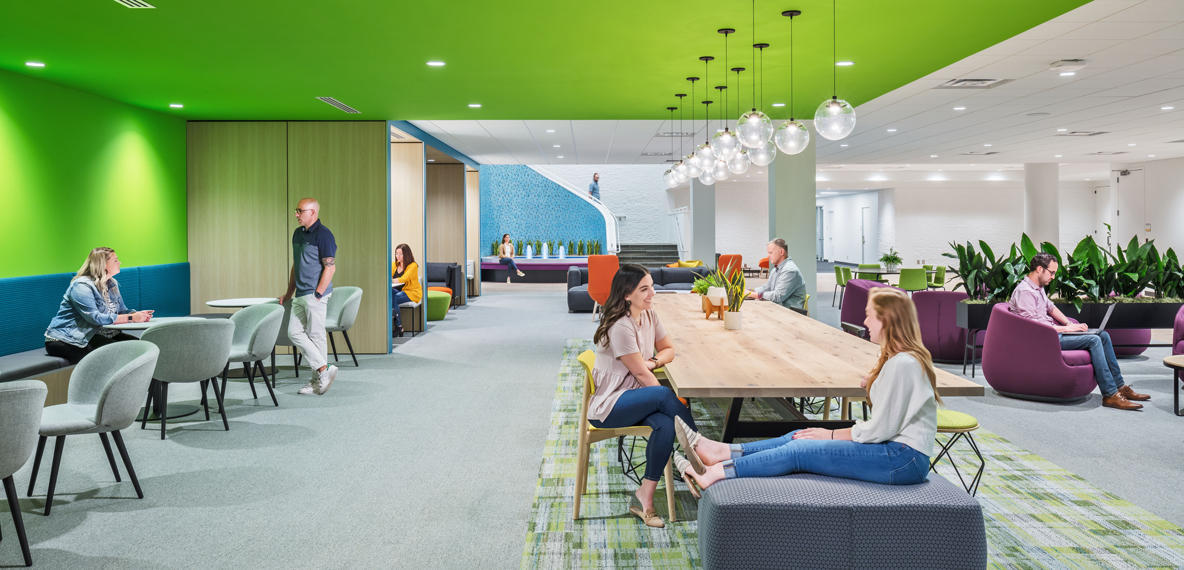
Read the full white paper below, or download a PDF copy.
The workplace is a complex ecosystem that extends beyond physical space. Architecture, interior design, and experiential graphics all have a role in reflecting and influencing organizational culture. In the workplace, they should encourage behaviors that lead to desired outcomes.
Even as hybrid work becomes the norm and the workplace changes, its importance remains as crucial as ever. To understand the full scope of the workplace, we must consider its three main elements: people, space, and technology.
PEOPLE
Undoubtedly, the most valuable resource in any organization is its people. However, the workplace can bring these diverse individuals together and guide them at three distinct levels: the individual, the team, and the organization. Unlike any other setting, a well-planned workplace can simultaneously support and enable these three levels, playing a crucial role in driving desired outcomes for the organization.
The Workplace Can Maximize Personal Productivity
A well-structured and supportive workplace can streamline tasks, reducing wasted time and resources. Employees will likely feel more satisfied and motivated when they can efficiently complete their tasks. This, in turn, can foster improved morale and a positive work environment. A productive environment offers opportunities for employees to enhance their skills, tackle new challenges, and advance in their careers. By emphasizing the workplace’s role in supporting personal growth, it is possible to inspire and motivate employees to strive for excellence.
On the macro-scale, one of the potential benefits of the workplace today is its ability to provide a more equal work environment for employee productivity. Hierarchical perks for executives aside, in most workplaces, everyone shares the same level of furniture, indoor environmental quality (IEQ), internet, space types, and amenities. Post-pandemic, many organizations have even begun to reverse traditional, hierarchical spatial messaging by pulling private offices away from exterior windows to provide natural light and views to everyone or even removing offices altogether. This is important to remember as the perception of remote work—specifically work from home—is one of private, concentrative spaces away from the “distracting” workplace; such is a privilege that not everyone has available to them. Younger employees or those less privileged may not have supportive work environments at home that are dedicated, private, ergonomic, and comfortable for productivity.
Personal productivity is the foundation that teams and the organization are built upon. The biggest challenge for the workplace, though, is balancing the diverse needs of individuals equitably due to variations in life experiences, cultural backgrounds, abilities, and personal preferences. This underscores the importance of inclusivity and the provision of diverse types of spaces to accommodate a wide range of cognitive and behavioral differences, encompassing introverts and extroverts, individuals in different roles, various generations, and the spectrum of neurodiversity. It’s not that these individual differences are new to the workplace, but with increasing awareness of such differences, they can no longer be overlooked. A well-designed workplace will adjust to individuals’ unique requirements, fostering a sense of being understood and appreciated, positively impacting productivity.
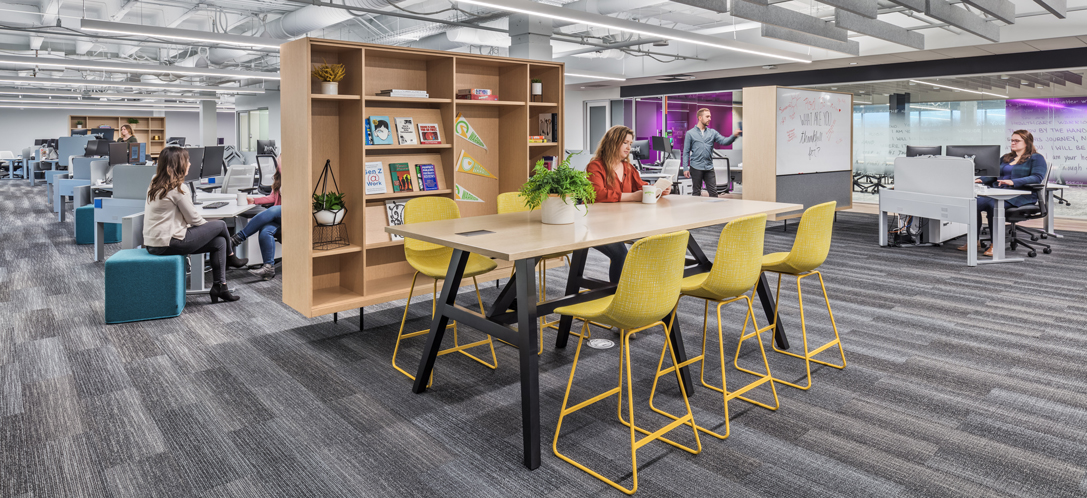
The Workplace Can Support Team Performance
High-performance teams rely on high trust, transparency, accountability, and empowerment to attain productivity, collaboration, and innovation. Research has found that intra-communication among team members is a core factor differentiating high- and low-performing teams. The quickest and best way to build such team norms and even rapport among team members is to spend time together physically. While coordination can be achieved remotely while managing the work, most teams benefit from some degree of in-person interaction to build the trust required to work toward longer-term outcomes. This was made quite clear during the pandemic as we saw the differences between those who went home to work with longer tenure versus those who were newer to the organization. Those who had been around longer experienced a minimal decrease in their ability to communicate and work together due to well-established routines, processes, and relationships; newer employees struggled to create relationships or even learn from those no longer present in their daily work lives.
While the pandemic sped up new forms of work and introduced many new processes and technologies, it also did so at the expense of teams. An unfortunate global side effect of the pandemic was people turning inward and focusing on themselves and their needs, a survival mechanism in response to the pandemic. This manifested in thoughts like “I need all of the toilet paper,” “I don’t want to wear a mask,” or even now, “I want to work from home and only go into the office on Thursdays.” It is no wonder that research shows that remote work leads to decreased feelings of attachment and team cohesion. When together physically, less planning, scheduling, and effort is needed than when team members are remote. Very few organizations have developed such intentionality as it requires a shift in culture and developing managers to manage hybrid teams. This also requires organizational culture to nudge individuals to prioritize the team’s needs. For instance, if someone prefers working from home on Mondays but most of the team meets in person on that day, it’s beneficial to prioritize being in the office with the team on Mondays.
While it was reported in the media that organizational productivity increased or at least there was no drop in such rates during work-from-home during the pandemic, it was not shared broadly that many organizations instead witnessed a decrease in innovation that remains today. How could productivity rise but innovation plummet? The ability to remove oneself from the fray and tackle concentrative work away from the workplace led to a greater reliance on asynchronous methods of working amongst teams, such as non-real-time communication and the sending of files. While such methods are good for conveying information and shutting out distractions (getting work done), old-school, synchronous methods of people in a room with a whiteboard are best for dealing with complex information and exchanging ideas (creating new ideas). This isn’t about remote vs in-person; people need to get work done (productivity) and develop new ideas (innovation), which requires being alone or together when necessary for the task. This is why the workplace needs both spaces for brainstorming and creating together as well as spaces to get away on one’s own to either drill down into that creativity or develop the execution of such ideas.
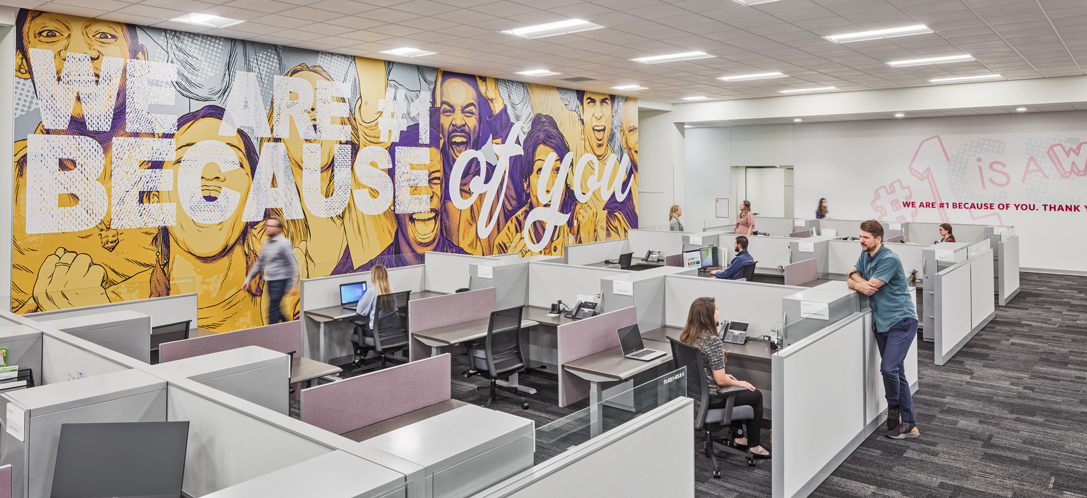
The Workplace Can Foster Social Connections and Sustain Organizational Culture
Social connectedness is a state of feeling close or connected to another person or other people. This includes feeling cared about by others (and caring about others) and belonging to a group or community. Humans are social creatures with a fundamental need to connect with others. Fulfilling this need is so important that our level of social connectedness influences nearly every aspect of our lives, including our psychological well-being, physical health, and even how long we live. We are currently experiencing the long-term effects of deteriorating social ties. The proof of this came with the Surgeon General of the United States declaring a national loneliness and social isolation epidemic throughout the country in 2023. In doing so, he shared that “about half of US adults are experiencing considerable levels of loneliness, which can affect physical, mental, and societal health.” The pandemic irrevocably changed the quantity and quality of people’s connections and still hasn’t rebounded. Just this year, he stated, “The most effective way for us to connect with another human being is still in person.”
The energy that people experience when coming together cannot be replicated virtually. We often just need the energy and buzz of other people working around us. Being around others is stimulating as long as we can regulate that stimulation. Just the simple act of seeing other people in the workplace is a benefit to our well-being. This even includes “consequential strangers,” those we don’t know personally but who also work for the same organization. Such strangers provide novelty and fresh perspectives, help define our identity, and present us with new opportunities, unlike strangers we may see outside work.
When people are together, it’s personal, and a well-balanced and flexible workplace will continue to support people when they come into the workplace. Each person’s vision of an ideal work environment may differ, requiring various environments to support individual work, small- scale huddles, structured team meetings, less formal team events, and periodic department- wide town halls. On-site amenities are necessary for people in the office, especially for therapeutic activities. Still, by themselves, they should not be viewed as a means to draw people into the office. The desire to forgo the commute and have the flexibility of schedule around one’s home-life activities overshadows any perceived benefit from on-site amenities. The two most enticing amenities tend to be on-site and, better yet, subsidized, such as childcare and dining, as they provide support for home-life activities but are not relevant to all employees. Balancing individual and organizational needs is perhaps the most significant challenge inherent in hybrid work.
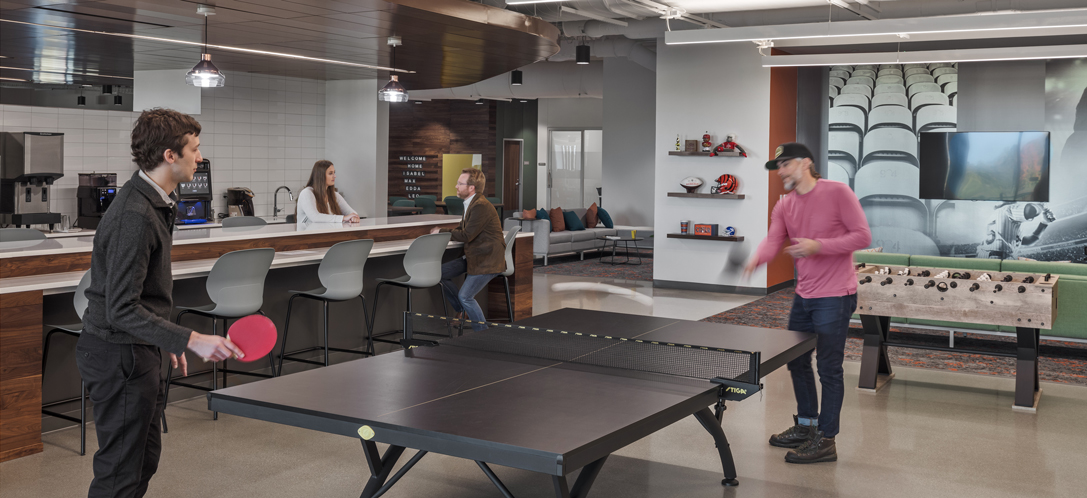
SPACE
All human activities occur in physical space. Architecture assists daily human functioning and affects how we feel and act, thus influencing mood, decisions, health, behavior, and overall experience. Workplaces are important because they reflect and shape our professional identities— who we were, who we are, and who we aspire to be in our professional lives. Over time, our identities become intertwined with our workplaces as we accumulate milestones, memories, and life- shaping experiences inside them.
Space also plays a major role in enabling the elements we seek in our work with others through an organization’s culture, such as trust, camaraderie, morale, collaboration, and mentorship. Time spent in the workplace together contributes to the quality of these critical elements; it’s tough to maintain a meaningful culture if employees don’t work within the culture. In-person work allows for more collaboration and brainstorming, which can lead to more creative and innovative ideas. This is especially true for jobs that require innovation as an output. Talking face-to-face and working on projects together in real time can lead to increased efficiency and stronger team dynamics. By working in physical proximity, there is the opportunity to get to know a co-worker and experience chance encounters that allow for exchanging ideas between co-workers, whether they know each other personally or not. This allows for those unscripted conversations, short or long, that lead to sparks of innovation that one does not get when working by oneself off-site. These are created, developed, and sustained in the workplace as a physical manifestation of an organization’s culture. Without employees physically present in the workplace, important aspects of successful companies such as company culture, sense of belonging, team cohesion, attachment, knowledge sharing, development, competence, creativity, and innovation will likely suffer.
To truly embrace and leverage the total value of space in the workplace, our thinking and approach must transcend the mere physical dimensions of space where work is done and comprised of three passive elements: length, width, and height. As environmental psychologist David Canter theorized, “place,” in contrast to “space,” is comprised of three active elements: social (activities), physical (attributes), and cultural (meaning). Thinking this way allows us to think about corporate real estate differently; in doing so, we perceive the workplace as a “place of work,” not just the space for work to be done. Focusing on just the first two elements of place, social and physical, will not fully support the creation of a place where people want to be and connect to, which in turn can result in a missed opportunity to positively affect both attitude and productivity. A clear sense of company culture goes a long way in attracting and retaining top talent and reinforces company values. The workplace is the place for fostering and reflecting culture; no matter the level of remote work an organization allows, the workplace is the cultural touchstone of an organization.
Ray Oldenburg introduced the idea of three distinct types of places: home (1st Place), work (2nd Place), and other (3rd Place), which includes public spaces like coffee shops, libraries, museums, and parks. These are very distinct settings with distinct mental, emotional, and physical associations. As the doing of work has become increasingly uncoupled from the places of doing work, there is an unprecedented blurring of these place types. What happens when remote work merges 1st and 2nd type places? Or when hybrid work obliterates the boundaries across 1st, 2nd, and 3rd places? The question then arises: do people feel the same about work at home or elsewhere as they do in the workplace?
While hybrid work has become less place- dependent, our organizations and their respective cultures have not. Our workplaces are critical to our identity, attitudes towards work, and behavior. So, what happens to one’s anchoring connection to an organization, its people, and the work itself if where the work gets done becomes increasingly uncoupled from the organization for which the work is done? Having a sense of place allows people to fulfill human connections. A place allows people to form a “place identity,” categorizing a place based on their self-perceptions. As people cultivate a place identity, the place aids them in processing their thoughts and emotions. Place identity plays a dual role: it helps people define their identity and fuels their self-efficacy and motivation to accomplish tasks. A place of work that supports activities (social), provides meaning (culture), and has pleasing attributes (physical), can inspire people to do their best work.
Without the physical separation between home (1st Place) and work (2nd Place), the blurring of places and boundaries between them can lead people to feel pressured to always be “on.” Beyond just needing to break up the monotony of one place serving as both home and work, the rhythm of going from home to work to home provides people a sense of time orientation. Otherwise, the constant connection to work can overwhelm one’s senses and keep them trapped in a state of work. Physical transitions between the different types of places can help one recharge and be one’s best self when at work. Recovery from and future engagement in one’s work relies on such boundaries.
From a practical standpoint, within the hybrid work ecosystem, the workplace is the only environment an organization can truly impact. It has no control over an employee’s home environment (1st Place) or what happens there, nor over the coffee shop (3rd Place). In a remote environment, an organization may provide software and hardware. However, in that remote setting, the individual still sits in a physical environment that the organization can’t influence. Only the organization’s workplace real estate can be transformed to enable its employees to be the best they can be focused on shared goals. The workplace is the one environment, out of all the others, that can be directed, guided, and harnessed. And all too surely, without a sound workplace strategy, it too can be just as dysfunctional as any other environment the organization doesn’t have control over.
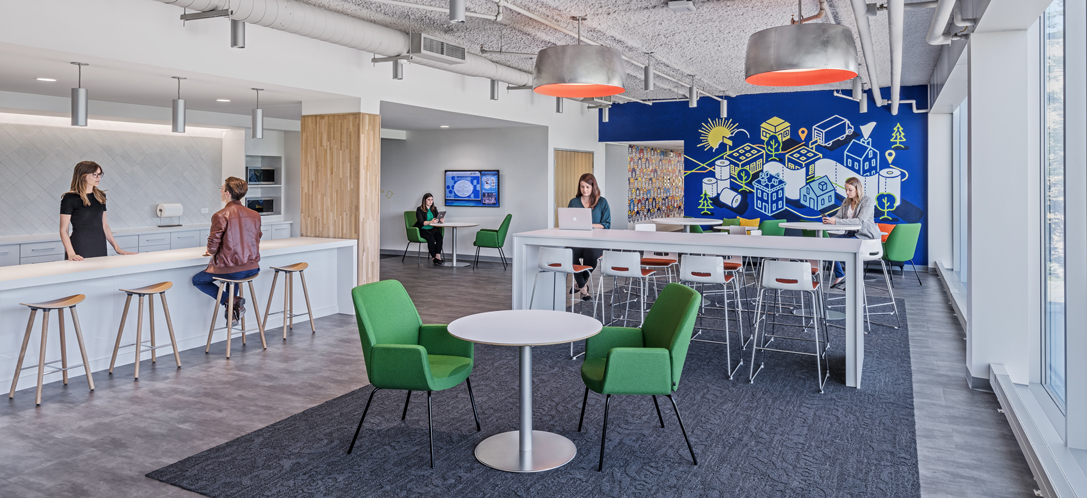
TECHNOLOGY
Technology cannot be left out of this conversation as now, more than ever, it is an enabler of work across space and people. Workplace technology needs to be part of the space strategy; it needs
to be seamless and adaptable in both form and function. The intentional integration of technology in workplace spaces can dramatically impact how successful these technologies are with people for their effectiveness and experience. For example, users always request a shared, quiet “library space” to work in with no distractions from people on audio or video calls or people coming up to them with questions. We’ve found, though, that such spaces won’t get used if there aren’t external monitors provided for connecting to their laptops. In addition, even the smallest meeting spaces, such as two-person huddles or booths, still need a monitor to share in that space with a colleague.
Assuming an effective technology strategy and a capable IT department to execute and deploy said strategy in the workplace, people in the workplace will have access to shared resources. Reliable, high-speed internet ensures all employees have access and bandwidth for their work, which might not be the case in a remote work setting at home or Starbucks. Employees can access high-end, specialized equipment or technology that can’t be set up at home, such as faster workstations, larger or multiple monitors, complex software, 3D printers, lab equipment, and more. People in the workplace also have access to secure networks for protecting sensitive data, whereas VPNs for remote workers may not offer the same level of security as an in-office network. Hardware and software consistency reduces compatibility issues versus remote employees using different systems, leading to workarounds that don’t really work. While many digital collaboration tools are available, some collaborative technologies are more effective and enjoyable in person. Interactive whiteboards, conferencing systems, and even simple things like Post-it notes on a physical board can be more intuitive and efficient for brainstorming and collaborative work.
People expect the technology in the office to be the fastest, newest, and best. And just as not having the right space type for the work activity will cause frustration and potential loss of trust in the workplace, ineffective technology will do so even more quickly. We have experienced this when beginning to collect user feedback at the front end of projects and consistently hear complaints of technology not being consistent from room to room, the technology being so burdensome to use that no one uses it, or there is a lack of clear instructions on how to use the technology. If technology at work doesn’t work (e.g., it lags, lacks connectivity, or is too complex) or worse yet, people have a better tech experience at home, that makes it that much harder to come into the workplace. That kind of inferior work experience will cause people to be frustrated and resentful of wasting their time, which erodes trust in the organization.
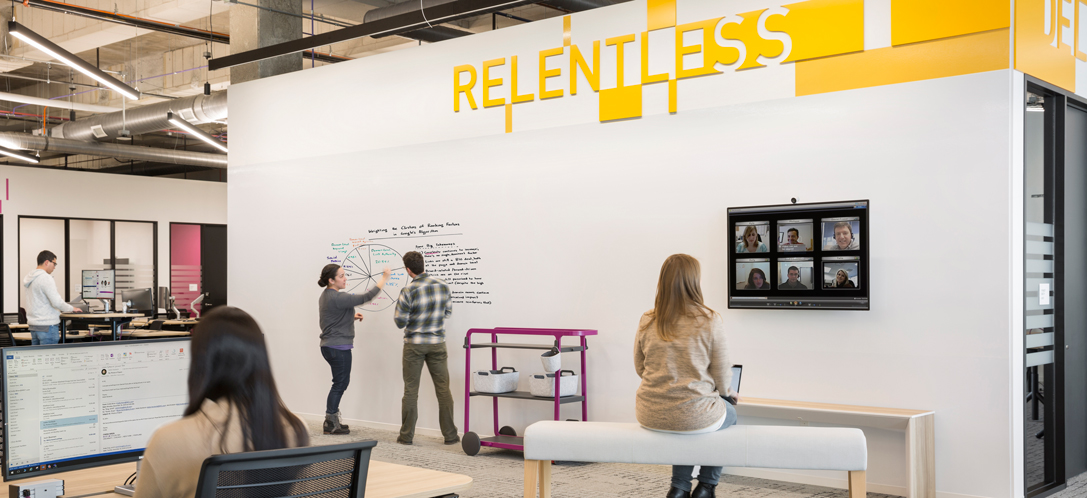
An Integrated Workplace Experience
Fortunately, the departments necessary to create a place of work encompassing these elements already exist in most organizations. HR (people), CRE (space), and IT (tech) each have a role to play in setting the stage for the overall work experience together. While the pandemic forced significant changes to how work is conducted and has allowed companies to examine where, when, and how work can be accomplished, unfortunately, there has been an apparent lack of interconnected strategy and execution between these three departments.
Such a lack of shared focus is significantly impacting innovation, productivity, effectiveness, wellness, and employee attraction and retention. A comprehensive approach leveraging the integrated knowledge and innovation of a company’s HR, CRE, and IT departments, along with others, will provide an impactful, integrated work experience for their people and their company for continued success in the future.
Not What, But Why?
For organizational leaders, the first and most crucial step is contemplating and delivering their “why.” Why is the workplace valuable to them and their people for what they need to do? Their goals, on top of their people, space, and technology requirements, are not the same as those of other organizations. To truly empower the workplace and get value out of it, a clear and compelling argument must be made to the entire organization, top to bottom, that aligns and drives the necessary individual behaviors, team norms, and shared expectations. In the end, the right question isn’t what value the workplace holds, but instead, whether the organization has the right culture in its people, the right types and amounts of space making up the place of work, and the right technology to enable it all in response to their “why.”
Conclusion
For those thinking otherwise, this is not a love letter to the physical workplace; it is not meant to set up an on- site versus remote binary of good and evil. Instead, it is a recentering of the physical workplace in the ongoing, ever-changing conversation about how and where we work. After asking themselves why the workplace is valuable, perhaps next is how it will sit within the larger hybrid ecosystem and continue to serve as the touchstone of culture. Intentionally planned for, hybrid is an excellent opportunity for organizations, but again, it does not diminish the value of the workplace. Instead, we need to be even more mindful about people, tech, and space in its execution.
We see this as optimizing workplaces and recalibrating them for people now, not based on decades-old needs and ways of working. Instead, the workplace truly becomes an environment that positively affects the key behaviors necessary to achieve strategic results for organizations. This will entail perceiving the workplace not as an architectural object made up of spaces but as a place of work generating outcomes of people doing their best work and living their best lives.
References and Notes
- Ashforth, B. E., Caza, B. B., & Meister, A. (2023). My place: How workers become identified with their workplaces and why it matters. Academy of Management Review.
- Canter, D. (1977) The Psychology of Place. Architectural Press, New York.
- Caza, B. B., Meister, A., & Ashforth, B. E. (2023). How your physical surroundings shape your work life. Harvard Business Review. HBR.
- Hofer, J., Busch, H., & Kärtner, J. (2011). Self-regulation and well-being: The influence of identity and motives. European Journal of Personality, 25(3).
- Kopec, D. (2024). Environmental Psychology for Design. Fairchild Books, New York.
- Oldenburg, R. (1989). The Great Good Place. Paragon House, New York.
- Pentland, A. “Sandy”. (2012). The new science of building great teams. HBR.
Author
Content Type
White Paper
Date
January 02, 2025
Market
Topic
Hybrid Work
Workplace Strategy


